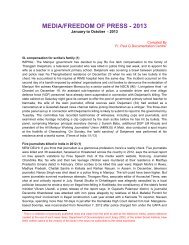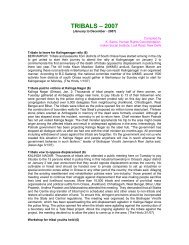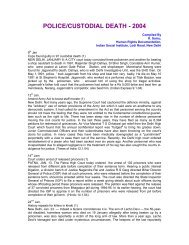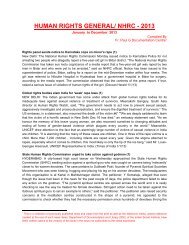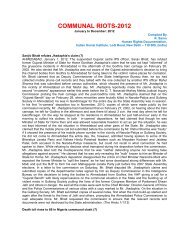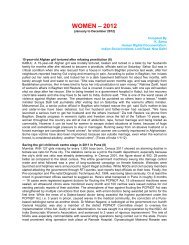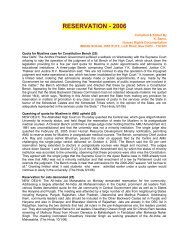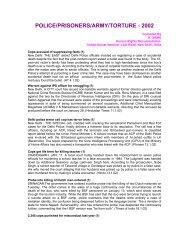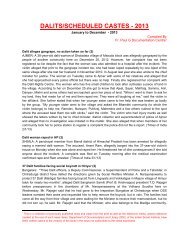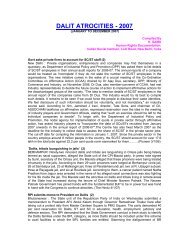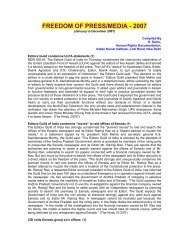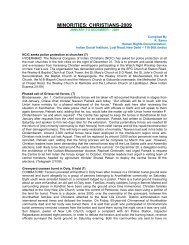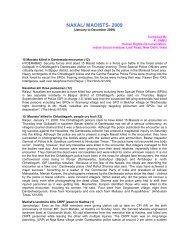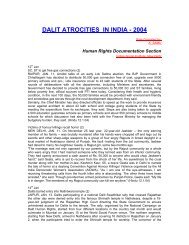Create successful ePaper yourself
Turn your PDF publications into a flip-book with our unique Google optimized e-Paper software.
Return our land, demand tribals (6)<br />
JAIPUR, JAN. 5. Dalits and tribals from southern Rajasthan, who reached here today on the com pletion of<br />
a 10-day-long march from Chittaurgarh, demanded that their land encroached upon and illegally occupied<br />
by the so-called higher castes be set free and restored to them in accord ance with the provisions of the<br />
Tenancy Act. Agricultural land measuring thousands of bighas belonging to Bheel tribals and Dalits in<br />
Chittaurgarh, Baran and Kota districts has been either trans ferred to the influential people of higher castes<br />
allegedly by subterfuge or declared as Gov ernment property by misuse of the legal provisions during the<br />
past two decades. The tribals claim that the provisions for restoration of land rights were hardly ever<br />
implemented. About 400 people traversed a distance of 327 kilometres on foot in ten days to reach Jaipur<br />
today to highlight their plight and demanded at a "Jan Sun-wai" (public hearing) that the il legal transfer of<br />
land owned by •Scheduled Castes and Tribes be stopped forthwith and their land rights be restored.<br />
Among others, noted social activist and member of the Na tional Advisory Council, Aruna Roy, president of<br />
the Rajasthan unit of People's Union for Civil Liberties, Than Singh, and Brah-madev Sharma of Bharat<br />
Jan Andolan, addressed the Jan Sunwai and emphasised the need to protect the land title of tribals and<br />
Dalits. A survey conducted by two non-Government organizations in Chittaurgarh district has re vealed that<br />
1,389-bigha agricul tural land of 415 Bheel families in 92 villages is currently in the possession of higher<br />
castes through mortgage or transfer of title. The total value of the land has been estimated at Rs. 10<br />
crores. (The Hindu 6.1.05)<br />
We are safe, say Jarawas (6)<br />
JIRKATANG, JAN. 6. Carrying bows and arrows, members of the an cient Jarawa tribe emerged on<br />
Thursday from their forest hab itat in the Andaman and Nicobar islands for the first time since the tsunami<br />
tragedy. In a rare interaction with out siders, the larawas said all 250 of their tribe had survived by flee ing<br />
inland. "We are all safe after the earthquake. We are in the forest in Balughat," said Ashu, an<br />
arrow-wielding tribesman. Even though the Jarawas sometimes interact with local of ficials to receive<br />
government-funded supplies, the tribe seemed wary of visitors. "My world is in the forest," Ashu said in<br />
broken Hindi through an in terpreter in a restricted area at the north end of South Andaman island. "Your<br />
world is outside. We don't like people from out side."<br />
There are only an estimated 400 to 1,000 members alive today from the tribes of Jarawas, Great<br />
Andamanese, Onges, Sentinelese and Shompens who live on the islands. Some anthropological<br />
DNA studies indicate that the generations of tribes may have spanned back 70,000 years. They originated<br />
in Africa and migrated to India through Indonesia, an thropologists said. Government officials and anthropologists<br />
believe that an cient knowledge of the movement of wind, sea and birds may have saved the<br />
indigenous tribes from the tsunami. Seven Jarawa men — wearing only un derwear and amulets —<br />
emerged from the forest to meet govern ment officials to say they had all managed to flee to the forest<br />
when the deadly waves came. They said they survived by eating coconuts in the aftermath of the tsunami,<br />
which killed 901 people and left 5,914 missing on the An daman and Nicobar islands. (The Hindu 7.1.05)<br />
Prosperous Nicobarese worst hit: Govt. report (6)<br />
New Delhi: The tsunami waves hit the nu merically large and more prosperous Nicobarese, the largest ST<br />
population living in the Car Nicobar plains, sparing much of the remaining tribal population in the An daman<br />
and Nicobar Islands. Still looking for the 3,000 missing Nico-barese and sending relief to the remaining,<br />
the Union home ministry has based its es timates, made public on Thursday, on the 2001 Census figures<br />
and reports from the is lands. It is still in the midst of surveying the damage in terms of life and property.<br />
The others — Andamanese (43), Jarawas (240), Onges (96), Sentinese (39), all primi tive tribes of people<br />
who belong to the Negrito group and Shorn Pens (398), who are of Mongloid extract — are either not affected<br />
or reported safe.<br />
The Census figures show that the STs, numbering 29,469, constitute only 8.27 per cent of the total<br />
3,56,152 population as on March 1, 2001. The actual numbers have registered marginal increase in the<br />
last three years. The islands in the popular perceptions are the home to several tribes, some of them<br />
endangered. But they have under gone demographic changes, particularly since Independence, when<br />
people from the mainland and refugees from the erstwhile East Pakistan settled there. Only about ten per<br />
cent of the STs live in the Andamans district, while the remain ing 90 per cent live in the Nicobars. Of the<br />
total Andamanese population of 43, (24 men and 19 women), inhabiting mainly Straits Island in Rangat<br />
tehsil, nine were found to be living in Port Blair town. Their habitats have suffered substantial damage and



